People With Flat Feet Can Still Run Comfortably With the Right Support

"Hearst Magazines and Yahoo may earn commission or revenue on some items through these links."
Editors’ Note: We updated this article in March 2024 with a new set of expert recommendations. We’ll continue to evaluate this list on a regular basis to make sure the models below represent the best running shoes for flat feet available now.
Shopping for running shoes can be especially frustrating if you have flat feet. There are conflicting opinions about what types of shoes best accommodate your foot shape. Some shoe brands add lots of arch support. Other experts say the opposite. What’s a flat-footed runner to do?
Despite the confusion, there are solutions out there. Roughly 25 percent of the population has flat feet. If you fall into that category, finding shoes that work with your feet, support good running form, and feel comfortable is paramount—and totally doable.
Not all flat feet are the same, which means there’s no universal solution that will work well for everyone. We’ll go over what it means to have flat feet and some of the potential issues the condition can present for runners. We’ve also highlighted shoe designs that might help alleviate any pain or discomfort you’re experiencing. Finally, we’ve picked the best running shoes for flat feet you can buy right now, including a wide range of options for walking, speedwork, trail running, and more.
The Best Running Shoes for Flat Feet
Best Overall: Brooks Adrenaline GTS 23
Best Value: Nike Pegasus 40
Best for Heavy Runners: Saucony Triumph 21
Best Stability: New Balance Fresh Foam X 860v13
Best Daily Trainer: Asics Gel-Kayano 30
The Expert (Caitlin Giddings): I’m a runner with high arches. To do this topic justice, I spoke to running experts Dr. Kimberly Davis of the RunLab and physical therapist Jay Dicharry, author of Anatomy for Runners. Both Davis and Dicharry have extensive experience assessing and treating runners of all experience levels, gait types, and footwear needs; they were able to provide significant insight on the topic. That, along with my own experience—I’ve tested, reviewed, and written about running shoes and gear for more than a decade for Runner’s World—helped inform my recommendations.
The Expert (Michael Charboneau): I’ve tested running and outdoor gear for years, both as an editor at Runner’s World and as a freelance reviewer for InsideHook, Men’s Journal, and other publications. I’ve written more about running shoes than any other category, and I have firsthand experience running in models from a range of brands.
[table-of-contents] stripped
What to Consider in a Flat-Footed Running Shoe
There Are Two Kinds of Flat Feet
Some runners have anatomically flat feet, and other runners have what’s known as “collapsed arches,” which are flat because of a muscle weakness. Although the two types can look very similar, how you approach buying shoes for them varies widely, says Dr. Kimberly Davis of the RunLab, an Austin, Texas-based clinic that assesses running biomechanics and offers physical therapy and training.
Dr. Davis says that when it comes to shopping for a shoe for a flat-footed runner with collapsed arches due to muscle weakness, you can add arch support until the foot gets stronger and can support its own arch. But with an anatomically flat foot, arch support just sends stress up into the knee where it can lead to knee problems.
That’s why it’s important to know what type of flat foot you have before you settle on a shoe—and take into account not just your foot but your entire body, including knees, hips, and range of motion.
Added Arch Support Is Not Always the Answer
Runners with flat feet tend to overpronate, which is when the arches of the foot roll inward after landing. (This isn’t true across the board—there are plenty of flat-footed runners who are biomechanically sound and efficient, and don’t experience any overpronation.)
Up until recently, the running industry steered overpronators toward stability shoes to control this motion. Gradually, all that is starting to change with the realization that stability features don’t do much to correct the natural cycle of the foot, though some runners prefer having them.
Dr. Davis says people with flat feet often have really flexible feet that never get rigid for the push-off. “The footwear industry tries to solve that by putting an arch support in there to give them an arch or create suppination in the foot,” she says. “But that foot is structurally built that way, it’s not something you can solve with a shoe.”
Flat-Footed Runners Can Benefit From a Full-Contact Midsole
Jay Dicharry, author of “Anatomy for Runners” and director of the REP Lab in Bend, Oregon, agrees arch support can be detrimental because the arch is by nature dynamic, and having extra structure there can stop your foot from moving. Dicharry says flat-footed runners should put more focus on seeking out a shoe with a straight “last,” which is the mold that dictates the shape of the shoe. A straight-lasted shoe has a wider midfoot base and less of a cut-in, a profile that has fallen by the wayside in favor of hourglass-shaped shoes.
Most current shoes don’t provide much of a solid support surface for flat-footed runners, he says. “The problem is all these hourglass shoe shapes look nice on the wall, but when someone with a flat foot puts weight on one, part of their foot is bearing weight on the fabric upper,” he says. “The upper doesn’t work as a midsole for foot support. Feet do well when they’re on an even surface.”
Flat Feet Are Just One Aspect Among Many
The truth is most running shoes will work for most runners; however, if the shoes you’re using aren’t comfortable immediately or if you’re experiencing any pain while running, you should try a different pair. Get your movement pattern analyzed, whether at a clinic like the RunLab or even a running store that offers gait analysis.
Once you have more information about your feet and movement patterns, you can provide all that information to a running store to find the best shoe for you. Don’t be afraid to take a shoe out for a test run following assessment before purchasing anything.
How We Evaluated The Best Running Shoes for Flat Feet
The shoes highlighted below are the result of research and testing from Caitlin, Michael, and the Runner’s World test team. In addition to putting these shoes through their paces, we consulted running experts about the needs of flat-footed runners, spoke with representatives at various shoe brands, and compared customer reviews of shoes recommended for flat feet.
Each of the shoes below was selected based on comfort, value, and overall performance, with a strong emphasis on features that work well for flat feet, such as a full-contact midsole and a wide sole. We set the lineup to cater to a wide variety of needs and preferences, including picks for road, trail, walking, and heavier runners. While running shoe fit and feel is highly subjective and we always recommend trying a pair before you buy, we’re confident that at least one of the options below should work well for you.
Shop the best flat-feet running shoe deals on Amazon
Our Reviews of The Best Running Shoes for Flat Feet

Adrenaline GTS 23
amazon.com
$139.95
Thomas HenggeThe Adrenaline GTS 23 isn’t designed specifically for flat feet, but it’s a highly versatile all-rounder with a comfortable feel and mild support features, which makes it a strong pick for flat-footed runners (or any runner for that matter).
The current design features a midsole made from DNA Loft v2, a lightweight rubber-EVA foam that offers a soft underfoot feel with good durability, so it will resist packing down and losing its softness during high-mileage training.
The shoe is also equipped with Brooks’ GuideRails, which add layers of firm, high-density foam to both sides of the midsole. The extra foam cradles your foot to keep it aligned within the shoe as you run.
Finally, the Adrenaline GTS 23 comes in wide and extra wide sizes—a boon for flat-footed runners. It has also earned the Seal of Acceptance from the American Podiatric Medical Association (APMA) for promoting good foot health.
The Adrenaline line has been a top choice for runners of all stripes for years. With its cushioned, stable feel and wide sole design, it’s an especially strong contender for flat feet.

Pegasus 40
nike.com
$140.00
Thomas HenggeThe Pegasus has been a stalwart member of the Nike lineup for decades, and the 40th revision of the shoe continues that tradition. It’s a versatile, comfortable training shoe and offers a relatively wide, naturally stable platform for flat feet.
The Peg 40 features a revamped upper for an improved fit: Nike tweaked the upper’s internal midfoot band to better accommodate varying arch heights and added padding around the ankle collar for a more comfortable, secure fit at the back of the foot. The shoe features a combo of React foam and Zoom Air units (air-filled cells placed within the midsole) to soak up impact forces and add some pep into your strides.
The Pegasus has notable benefits for flat-footed runners. In my testing, I found the cushioning to be relatively firm, which can be a good thing for flat feet: It prevents them from rolling inward too much at landing. In addition, the sole design is wide and accommodating, especially for a Nike shoe. And if you need more space, it comes in extra wide sizes, too.
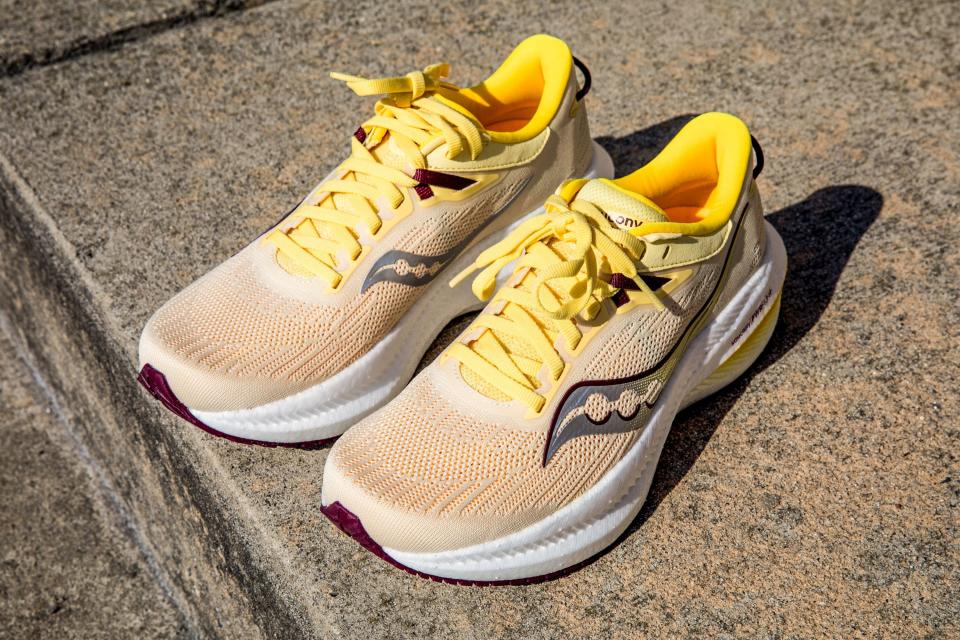
Triumph 21
amazon.com
$159.95
Thomas HenggeSaucony says the Triumph 21 is one of its best shoes for flat-footed runners. Based on our testing, we would add that it’s specifically a good choice for heavier runners, who may struggle to find a shoe that’s well-cushioned without feeling mushy. The Triumph 21 offers plenty of padding, but isn’t overly soft, so it won’t feel unstable.
The Triumph is a neutral max-cushion trainer. The midsole is packed with Saucony’s Pwrrun+ foam, a thermoplastic polyurethane (TPU) bead foam that’s bouncy and durable. The upper is made from a flat-knit mesh, and it comes with generous padding around the ankle.
In our test runs with the shoe, we really appreciated the Triumph’s comfortable fit. It created a secure wrap around the back of the foot with plenty of space in the toe box. That gives it a balanced ride—there’s plenty of cushion, but it’s also firm and stable. RW testers also loved the shoe’s midsole design.
“Despite being so cushioned, they never felt too dense or like they were sapping my energy,” said one tester.

Fresh Foam X 860v13
amazon.com
$135.00
The Fresh Foam X 860v13 is New Balance’s stability-oriented trainer, and it utilizes a host of midsole tech to support your feet and counter overpronation, which is a common problem for flat-footed runners.
The 860’s midsole features Fresh Foam X, a soft EVA-based cushioning foam, as well as a firmer layer of foam called a medial post along the inside edge of the sole. The firm medial post supports your foot and prevents it from rolling too far inward during your stride. The upper also provides support, creating a close wrap around your foot to help it stay aligned within the shoe while running. With so much support tech, it’s no surprise the 860 earned the APMA Seal of Acceptance for promoting foot health.
Not every flat-footed runner needs so much support to guide their strides—it’s really a matter of preference and what feels comfortable on your feet. If extra support helps you,bvthe 860v13 is an obvious choice.
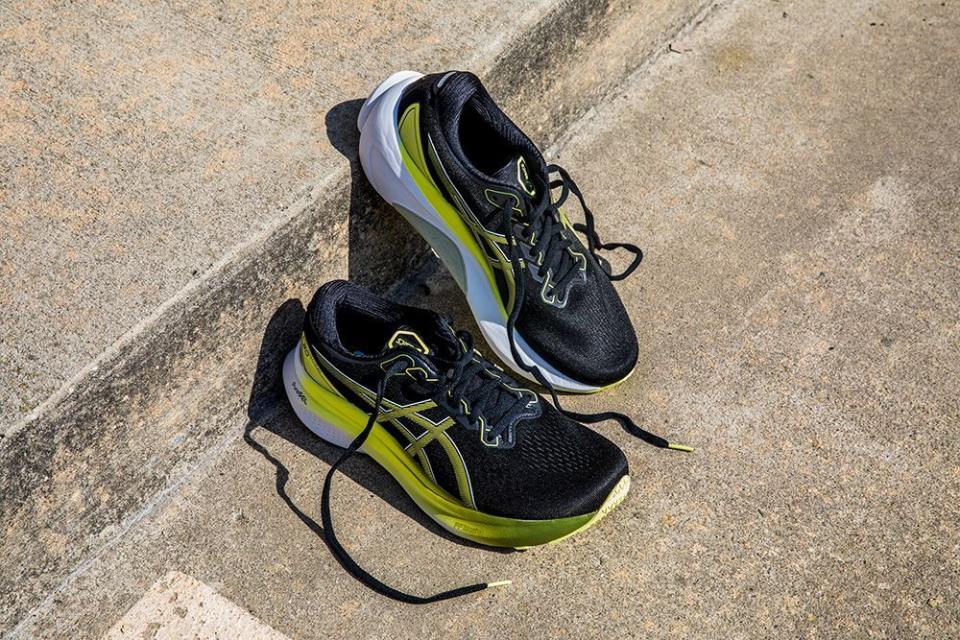
Gel-Kayano 30
amazon.com
$159.95
Thomas HenggeThe Gel-Kayano is a workhorse training shoe and one of Asics’ most well-known models. Like the New Balance Fresh Foam X 860v13, it’s designed for support. On a recent run, this pair impressed us with their comfortable feel, smooth ride, and spacious fit.
The Gel-Kayano’s midsole is made with FlyteFoam Blast+, a lightweight and responsive foam, and PureGel, a squishy, gel-like layer that adds extra softness in the heel. It also features a wide sole shape, which creates a stable, planted ride, and a piece of dense foam embedded on the medial side of the sole to bolster the arch of the foot. Asics likes to call this set of features its “4D Guidance System.”
On our test runs, the Gel-Kayano felt smooth and comfortable. The wide, full-contact sole created easy transitions from landing to toe-off, and the cushioning softened impacts (especially when running downhill). We also loved the roomy fit in the toe box and at midfoot. With its accommodating design and stable ride, it’s a superb trainer for flat-footed runners.
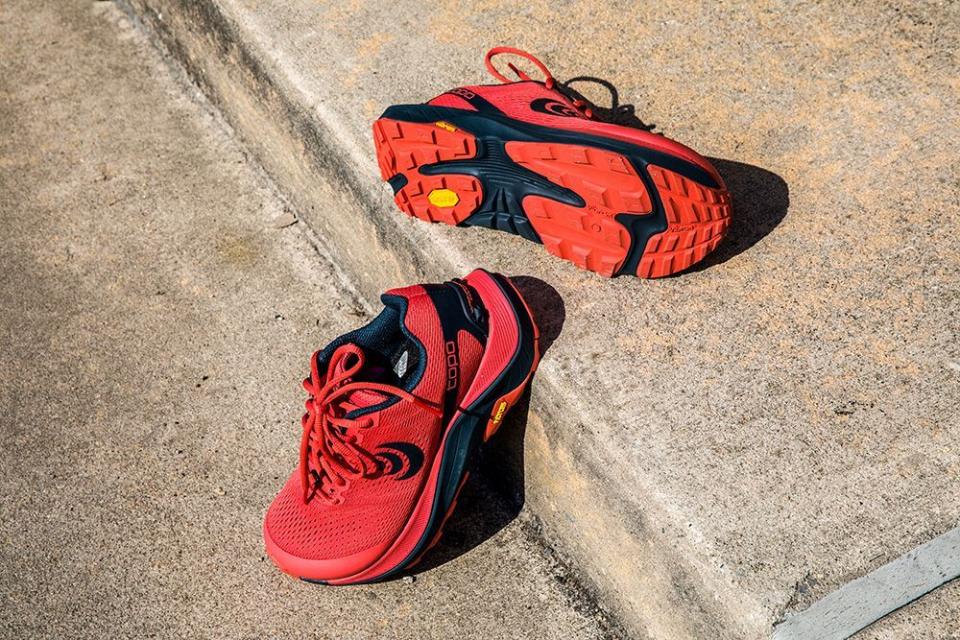
Ultraventure 3
amazon.com
$149.95
Thomas HenggeTopo Athletic’s Ultraventure 3 is a lightweight, well-cushioned trail shoe with a spacious fit, and it’s a good choice for flat-footed runners looking to explore mellow to moderate trails. Compared to the previous model, the Ultraventure 3 features even more cushioning, but still manages to be lighter than ever.
Like all Topo shoes, the Ultraventure 3 features a roomy toe box that provides plenty of space for your toes to spread out, which is essential for stability on rough ground and ideal for flat feet. Topo boosted the stack height in the new model, adding even more ZipFoam cushioning for a softer underfoot feel. The full-contact sole design promotes smooth transitions with each step.
On the bottom, the Ultraventure wears a Vibram XS Trek EVO outsole with shallow, widely spaced lugs, which are great for hard-packed dirt. It’s also scored with grooves at the forefoot and midfoot to improve the shoe’s flexibility. With its wide, well-cushioned design, the Ultraventure is a compelling option for flat-footed trail runners.

Fresh Foam X 880v14
amazon.com
$139.99
The New Balance Fresh Foam X 880v14 is a neutral trainer—an essential shoe in any running brand’s lineup—which distinguishes itself with its well-cushioned, full-contact sole design and spacious fit. Available in both wide and extra-wide sizes, this is a shoe that every runner with wide feet should know about.
New Balance’s Fresh Foam X compound, a supremely soft EVA-based cushioning foam, gives the 880’s midsole its notable shape. (There’s no pinched “hourglass” shape at midfoot.) It also provides a plush platform that nicely accommodates larger feet. The structured upper lends a bit of support as well, and creates a comfy fit. On the bottom, large rubber placements under the forefoot and heel give this shoe high-mileage durability.
With a design that prioritizes comfort in every step and its large size range, the 880 is an ideal match for wide-footed runners.

Tempus
amazon.com
$92.65
The Tempus is a support-focused trainer and one of Saucony’s recommended models for flat feet. It stands out among support shoes because of its low weight and peppy cushioning compound, both of which make it a stellar choice for running long.
The midsole is the highlight of this shoe. It’s made with a core segment of Pwrrun PB, an exceptionally springy polyether block amide (PEBA) foam, that spans the full length of the shoe. It’s paired with a contoured “frame” of Pwrrun EVA foam that cradles the foot for support. Together, the two foams generate a stable, well-cushioned ride with a propulsive feel that RW testers loved.
The shoe is topped off with a lightweight mesh upper to keep your feet cool, even as the miles stack up. For long runs, the Tempus is a treat that keeps you light on your feet.

Fresh Foam X 1080v13
amazon.com
$164.99
Thomas HenggeThe 1080 is New Balance’s ultra-plush training shoe, and while it certainly works for running, the shoe’s soft midsole and comfortable fit are great for a casual stroll, too.
We loved the generous layer of pillowy Fresh Foam X cushioning. The 1080 makes every step feel like you’re running on marshmallows. Our feet noticeably squished into the sole with each step, and combined with the shoe’s ankle padding and spacious toe box, the 1080 served up a luxuriously soft and comfortable ride.
That gooey soft cushioning isn’t going to work for everyone, of course. And, on a run, we noticed that the upper wasn’t especially breathable. Even so, it’s one of Michael’s favorite shoes from recent testing. Ideal for comfortable cruising, it really shines on walks and slow-paced workouts where you can let yourself luxuriate in each squishy step.
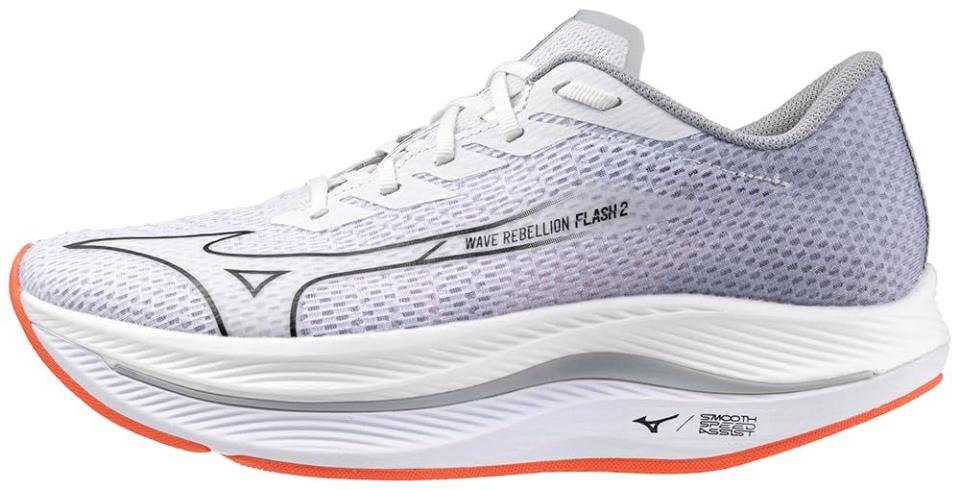
Wave Rebellion Flash 2
amazon.com
$144.65
The Wave Rebellion Flash 2 is the training-oriented counterpart to Mizuno’s Wave Rebellion Pro racing shoe. Although it has a somewhat pinched hourglass sole shape, which isn’t ideal for flat feet, it’s relatively wide for a speed shoe, and is an excellent sprinter.
The Wave Rebellion Flash features a combo of Enerzy and Enerzy Lite EVA-based foams, which are paired with a glass fiber-infused nylon midsole plate. The plate stabilizes the foot from landing to toe-off, helping you get maximum energy return out of the cushioning. The sole also has a rocker shape, curving up at the heel and forefoot. All of these features work together to create a balanced ride with good impact absorption, smooth transitions and plenty of spunky responsiveness. If you want to go fast, the Wave Rebellion Flash 2 is the shoe to help you do it.
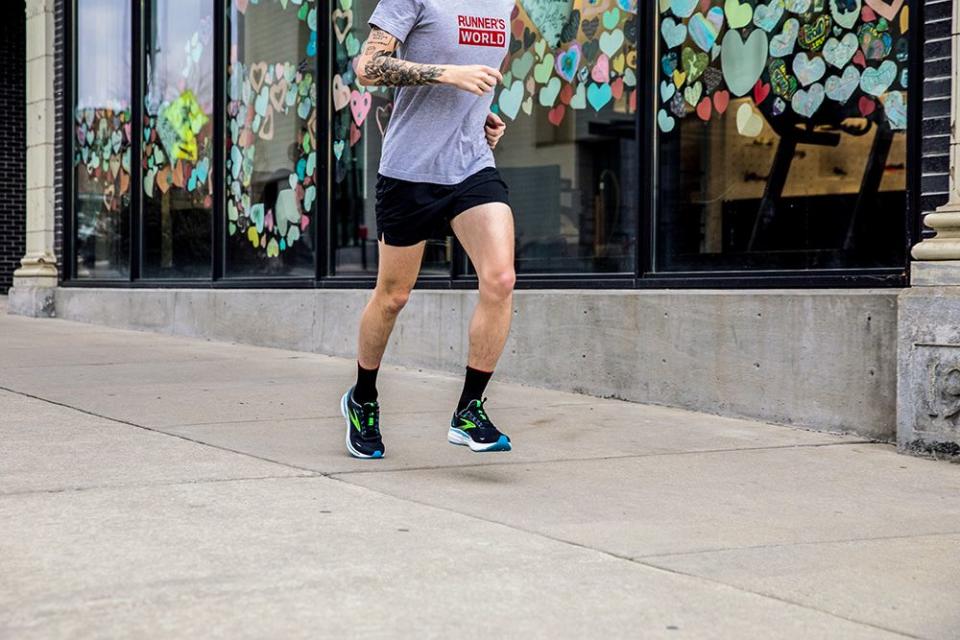
Q+A With Our Experts
How can I tell if I have flat feet?
Here’s a quick way to find out what kind of arches you have: Grab a piece of cardboard and head to the bathroom. Put the cardboard on the floor, wet the bottom of your feet with water in the bathtub or shower, then stand on the cardboard. If you see dry spaces where your arches are, you don’t have flat feet; if you see full footprints showing both soles, then your feet are flat.
As we noted in our explainer, there are multiple kinds of flat feet, and some feet are more flat than others. For a clear, detailed understanding of your foot shape and what kind of foot support you need, you should speak to a podiatrist or running expert.
How can I tell if I have naturally flat feet or collapsed arches?
People with naturally flat feet generally have the condition their entire lives. (Everyone is born with flat feet. Your arches develop in the first few years of life.) Collapsed arches are caused by muscle weakness or an injury. According to the Cleveland Clinic, the most common cause is “inflammation or a tear in the leg tendon (posterior tibial tendon) that supports the arch.”
Both naturally flat feet and collapsed arches can be painful, however, so if you’re experiencing discomfort, it’s best to consult with a doctor to determine which type you have.
My flat feet are causing pain and discomfort. What can I do to alleviate that?
Experts recommend stretching your Achilles, calves, and hamstrings. Stretching those tendons and muscles will help reduce strain on your feet. See our guides to strengthening and stretching the Achilles, calves, and hamstrings for specific exercises.
You Might Also Like

